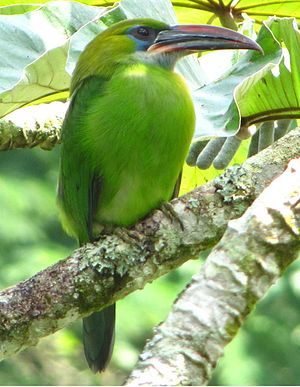Blue bridle macaws
| Blue bridle macaws | ||||||||||
|---|---|---|---|---|---|---|---|---|---|---|

Blue-bridled macaws ( Aulacorhynchus sulcatus ) |
||||||||||
| Systematics | ||||||||||
|
||||||||||
| Scientific name | ||||||||||
| Aulacorhynchus sulcatus | ||||||||||
| ( Swainson , 1820) |
The blue bridle macaws ( Aulacorhynchus sulcatus ) is a species from the toucan family . It only occurs in northern South America. Two subspecies are described, which differ mainly in the color of the beak. The IUCN classifies the blue bridled macaw as ![]() (= least concern - not endangered). There are no exact population figures for this species. However, it is still considered locally frequent.
(= least concern - not endangered). There are no exact population figures for this species. However, it is still considered locally frequent.
Appearance
Adult blue-bridled macaws are 34 to 36 centimeters long. The males of the nominate form reach a wing length of 11.5 to 13.2 centimeters. The tail accounts for 10.9 to 12.4 centimeters. The beak has a length between 6.6 and 8.43 centimeters. The animals weigh between 158 and 200 grams. Females are only slightly smaller and lighter. The only noticeable difference between the sexes is the length of the beak. It is 5.5 to 7 centimeters in females.
Adult birds of this species have green body plumage, the face and the underside of the body are only slightly lighter than the upper side of the body. The front cheeks and a narrow rein strip are light blue, the featherless eye area is brown, the fletching on the chin and throat is pale white with narrow gray-blue tips. It turns into a yellow-green on the sides. The tail feathers are dark green, the four central feathers have blue tips. The lower bill is straight, while the upper bill is curved. It ends in a sharp point. The beak color varies between brown and red or yellow-green and brownish.
There is a possibility of confusion with the Laucharassari and the Blutbürzelarassari , whose areas of distribution each partially overlap with that of the Blue-bridled Macarassar. However, the blue-bridled macaw lacks the chestnut-brown tips on the tail feathers and the red or red-brown body parts that are found in these two species.
voice
The vocalizations of the blue bridle arassari consist of a series of guttural sounds. They are described as grunting, barking, croaking to duck-like croaking. Males tend to call in a slightly darker tone than the females.
distribution and habitat
The blue-bridled macaw is a species of bird that prefers to live at high altitude. It occurs in the mountains in northeast Colombia , the Andes of Venezuela and the coastal mountains in northern Venezuela. In Colombia it is typically found at altitudes between 900 and 2,000 meters. In the north of Venezuela it usually lives between 800 and 2,000 meters, but is occasionally observed at 400 meters. Its habitat are subtropical moist forests. In some regions it also occurs in the edge area of temperate forests and populates among other things secondary forest, forest edges, isolated groups of trees near forests and tree-lined gardens. It used to be watched to the limits of the Caracas suburbs . In principle, however, this species does not cross larger, more open areas.
Way of life
The blue-bridled macaws are observed individually, in pairs and in small groups of up to ten individuals. The diet has not yet been adequately investigated, but the blue-bridled macaws are considered omnivores, which regularly rob nests of other bird species and eat nestlings and eggs. The reproductive behavior has not yet been researched. The breeding season probably falls between March and July.
supporting documents
literature
- Werner Lantermann: Toucans and Arassaris. Filander Verlag, Fürth 2002, ISBN 3-930831-46-5 .
- Lester L. Short and Jennifer FM Horne: Toucans, Barbets and Honeyguides - Ramphastidae, Capitonidae and Indicatoridae. Oxford University Press, Oxford 2001, ISBN 0-19-854666-1 .
Web links
- Aulacorhynchus sulcatus onthe IUCN 2011 Red List of Threatened Species . Listed by: BirdLife International, 2009. Retrieved January 2, 2012.
- BirdLife International: Species Factsheet - MGroove-billed Toucanet ( Aulacorhynchus sulcatus ) . Retrieved January 2, 2012.
- Videos, photos and sound recordings for Groove-billed Toucanet (Aulacorhynchus sulcatus) in the Internet Bird Collection
- Blue bridle macaws ( Aulacorhynchus sulcatus ) at Avibase; Retrieved January 2, 2012.
- xeno-canto: Sound recordings - Groove-billed Toucanet ( Aulacorhynchus sulcatus )